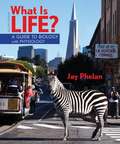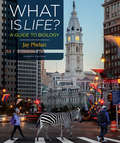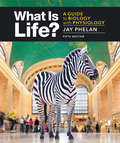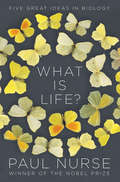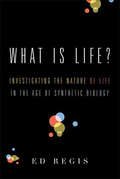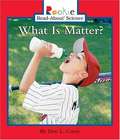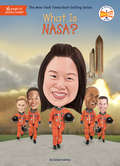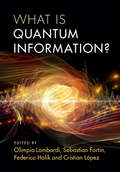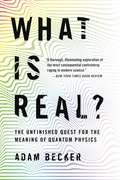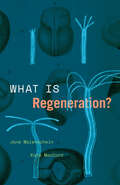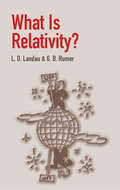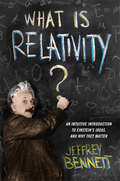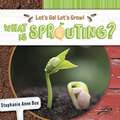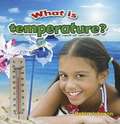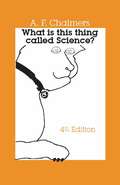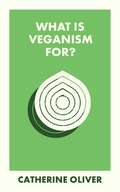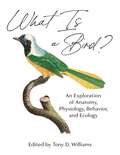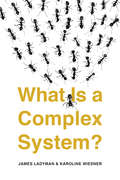- Table View
- List View
What Is Life? A Guide to Biology with Physiology
by Jay PhelanThe most successful new non-majors biology textbook in a decade returns in a vigorously updated new edition--with every chapter of the book carefully revised by Jay Phelan, based on the feedback of hundreds of instructors and students. The Second Edition brings forward the book's hallmark features (clear and consistent illustrations, beautiful photographs, Take-Home Message summary sections, StreetBio: Knowledge You Can Use, and Red Q Questions) while adding new pedagogy, updated content, and expanded media/supplements package. Click here to watch a sample of our Lecture Videos featuring What Is Life? with Physiology author, Jay Phelan.
What Is Life?: A Guide To Biology
by Jay PhelanFrom the front of the classroom to the top of the bestseller's list, award-winning educator Jay Phelan knows how to tell the story of how scientists investigate the big questions about life. He is also a master at using biology as a springboard for developing the critical thinking skills and scientific literacy that are essential to students through college and throughout their lives. Phelan's dynamic approach to teaching biology is the driving force behind What Is Life?--the most successful new non-majors biology textbook of the millennium. The rigorously updated new edition brings forward the features that made the book a classroom favorite (chapters anchored to intriguing questions about life, spectacular original illustrations, innovative learning tools) with new features, enhanced art, and full integration with its own dedicated version of LaunchPad--W. H. Freeman's breakthrough online course space, which fully integrates an interactive e-Book, all student media, a wide range of assessment and course management features, in a new interface in which power and simplicity go hand in hand. See what's in the LaunchPad
What Is Life?: A Guide To Biology
by Jay PhelanAvailable for the first time with Macmillan's new online learning tool, Achieve, What Is Life? teaches students to ask the questions they need to understand how biology plays out in their daily lives. The rigorously updated 5th edition brings forward the features that made the book a classroom favorite (chapters anchored to intriguing questions about life, spectacular original illustrations, innovative learning tools) with a more focused and flexible presentation, enhanced art, and full integration with Achieve, Macmillan’s new online learning system. <p><p> Achieve supports educators and students throughout the full range of instruction, including assets suitable for pre-class preparation, in-class active learning, and post-class study and assessment. The pairing of a powerful new platform with outstanding biology content provides an unrivaled learning experience.
What Is Life?: Five Great Ideas In Biology
by Paul NurseThe Nobel Prize–winning scientist’s elegant explanation of the fundamental ideas in biology and their uses today. The renowned biologist Paul Nurse has spent his career revealing how living cells work. In What Is Life?, he takes up the challenge of describing what it means to be alive in a way that every reader can understand. It is a shared journey of discovery; step-by-step Nurse illuminates five great ideas that underpin biology—the Cell, the Gene, Evolution by Natural Selection, Life as Chemistry, and Life as Information. He introduces the scientists who made the most important advances, and, using his personal experiences in and out of the lab, he shares with us the challenges, the lucky breaks, and the thrilling eureka moments of discovery. Nurse writes with delight at life’s richness and with a sense of the urgent role of biology in our time. To survive the challenges that face us all today—climate change, pandemic, loss of biodiversity and food security—it is vital that we all understand what life is.
What Is Life?: Investigating the Nature of Life in the Age of Synthetic Biology
by Ed RegisIn 1944, the Nobel Prize–winning physicist Erwin Schrödinger published a groundbreaking little book called What Is Life? In fewer than one hundred pages, he argued that life was not a mysterious or inexplicable phenomenon, as many people believed, but a scientific process like any other, ultimately explainable by the laws of physics and chemistry. Today, more than sixty years later, members of a new generation of scientists are attempting to create life from the ground up. Science has moved forward in leaps and bounds since Schrödinger's time, but our understanding of what does and does not constitute life has only grown more complex. An era that has already seen computer chip–implanted human brains, genetically engineered organisms, genetically modified foods, cloned mammals, and brain-dead humans kept "alive" by machines is one that demands fresh thinking about the concept of life.While a segment of our national debate remains stubbornly mired in moral quandaries over abortion, euthanasia, and other "right to life" issues, the science writer Ed Regis demonstrates how science can and does provide us with a detailed understanding of the nature of life. Written in a lively and accessible style, and synthesizing a wide range of contemporary research, What Is Life? is a brief and illuminating contribution to an age-old debate.
What Is Matter Made of?: Science Techbook, Grade 5, Unit 1
by Inc. Discovery EducationNIMAC-sourced textbook
What Is Matter?
by Don L. CurryThis Rookie Read-About Science book introduces young readers to matter. Colorful photos and simple text encourage children to read on their own as they learn that matter is everywhere and that solids, liquids, and gases are kinds of matter.
What Is NASA? (What Was?)
by Sarah Fabiny Who HQFind out all about NASA in this out-of-this-world addition to the What Was? series. The National Aeronautics and Space Administration, better known as NASA, began in 1958. With its creation, the United States hoped to ensure it won the space race against the Soviet Union. Author Sarah Fabiny describes the origins of NASA, the launching of the Apollo program that landed the first human on the moon, and the many missions and discoveries that have taken place since then. NASA has a rich history and still plays an important role in uncovering the mysteries of the universe. Readers are sure to get sucked into this book.
What Is Quantum Information?
by Olimpia Lombardi Sebastian Fortin Federico Holik Cristian LópezCombining physics and philosophy, this is a uniquely interdisciplinary examination of quantum information science which provides an up-to-date examination of developments in this field. The authors provide coherent definitions and theories of information, taking clearly defined approaches to considering information in connection with quantum mechanics, probability, and correlations. Concepts addressed include entanglement of quantum states, the relation of quantum correlations to quantum information, and the meaning of the informational approach for the foundations of quantum mechanics. Furthermore, the mathematical concept of information in the communicational context, and the notion of pragmatic information are considered. Suitable as both a discussion of the conceptual and philosophical problems of this field and a comprehensive stand-alone introduction, this book will benefit both experienced and new researchers in quantum information and the philosophy of physics.
What Is Real?: The Unfinished Quest for the Meaning of Quantum Physics
by Adam BeckerThe untold story of the heretical thinkers who dared to question the nature of our quantum universeEvery physicist agrees quantum mechanics is among humanity's finest scientific achievements. But ask what it means, and the result will be a brawl. For a century, most physicists have followed Niels Bohr's Copenhagen interpretation and dismissed questions about the reality underlying quantum physics as meaningless. A mishmash of solipsism and poor reasoning, Copenhagen endured, as Bohr's students vigorously protected his legacy, and the physics community favored practical experiments over philosophical arguments. As a result, questioning the status quo long meant professional ruin. And yet, from the 1920s to today, physicists like John Bell, David Bohm, and Hugh Everett persisted in seeking the true meaning of quantum mechanics. What Is Real? is the gripping story of this battle of ideas and the courageous scientists who dared to stand up for truth.
What Is Regeneration? (Convening Science: Discovery at the Marine Biological Laboratory)
by Jane Maienschein Kate MacCordTwo historians and philosophers of science offer an essential primer on the meaning and limits of regeneration. In punishment for his stealing fire, the Greek gods chained Prometheus to a rock, where every day an eagle plucked out his liver, and every night the liver regenerated. While Prometheus may be a figure of myth, scholars today ask whether ancient Greeks knew that the human liver does, in fact, have a special capacity to regenerate. Some organs and tissues can regenerate, while others cannot, and some organisms can regenerate more fully and more easily than others. Cut an earthworm in half, and two wiggly worms may confront you. Cut off the head of a hydra, and it may grow a new head. Cut off a human arm, and the human will be missing an arm. Why the differences? What are the limits of regeneration, and how, when, and why does it occur? In this book, historians and philosophers of science Jane Maienschein and Kate MacCord explore biological regeneration, delving into a topic of increasing interest in light of regenerative medicine, new tools in developmental and neurobiology, and the urgent need to understand and repair damage to ecosystems brought on by climate change. Looking across scales, from germ, nerve, and stem cells to individual organisms and complex systems, this short and accessible introduction poses a range of deep and provocative questions: What conditions allow some damaged microbiomes to regenerate where others do not? Why are forests following a fire said to regenerate sometimes but not always? And in the face of climate change in the era called the Anthropocene, can the planet regenerate to become healthy again, or will the global ecosystem collapse?
What Is Relativity? (General Science)
by G. B. Rumer L. D. LandauThis compelling book offers readers with no technical expertise beyond arithmetic an enlightening tour of the paradoxes inherent in the special theory of relativity, guided by a pair of eminent theoretical physicists.Novel Prize physicist L. D. Landau and his distinguished colleague G. B. Rumer, employ a simple and straightforward manner to illuminate relativity theory's more subtle and elusive aspects. Using such familiar objects as trains, rulers, and clocks, the authors explain the reasoning behind seemingly self-contradictory ideas in which the relative seems absolute, but the absolute proves to be relative. A series of playful cartoons highlights the authors' witty observations on the laws governing inertia, the speed of light, the relationship of work and mass, and other relativistic concepts.
What Is Relativity?: An Intuitive Introduction to Einstein's Ideas, and Why They Matter
by Jeffrey BennettA renowned astrophysicist&’s approachable introduction to Albert Einstein&’s theory of relativity and its application in our daily lives. It is commonly assumed that if the Sun suddenly turned into a black hole, it would suck Earth and the rest of the planets into oblivion. Yet, as prominent author and astrophysicist Jeffrey Bennett points out, black holes don't suck. With that simple idea in mind, Bennett begins an entertaining introduction to Einstein's theories of relativity, describing the amazing phenomena readers would actually experience if they took a trip to a black hole. The theory of relativity reveals the speed of light as the cosmic speed limit, the mind-bending ideas of time dilation and curvature of spacetime, and what may be the most famous equation in history: E = mc2. Indeed, the theory of relativity shapes much of our modern understanding of the universe. It is not &“just a theory&”―every major prediction of relativity has been tested to exquisite precision, and its practical applications include the Global Positioning System (GPS). Amply illustrated and written in clear, accessible prose, Bennett's book proves anyone can grasp the basics of Einstein's ideas. His intuitive, nonmathematical approach gives a wide audience its first real taste of how relativity works and why it is so important to science and the way we view ourselves as human beings. &“Well-written and uniquely readable . . . Bennett carefully avoids bombastic statements and &“spectacularization&” of the subject.&” —Alberto Nicolis, Columbia University &“I have read lots of introductions to relativity, but none is as clear and compelling as this one.&” —Seth Shostak, Senior Astronomer, SETI Institute
What Is Sprouting? (Let’s Go! Let’s Grow!)
by Stephanie Anne BoxIntroduce your child to science, biology, and plant life with the children’s book What Is Sprouting?Did you know that plants are also living things? Learn about the life cycle of a plant from its beginnings as a seed to how they are helpful to humans.Storybook Features:This children’s book features new vocabulary, a photo glossary, an index, and reading activity.24 pages of vivid photographsLexile 290LAbout RourkeWe proudly publish respectful and relevant non-fiction and fiction titles that represent our diverse readers, and are designed to support reading on a level that has no limits!
What Is Temperature? (Weather Close-Up)
by Robin JohnsonTemperature is a measure of how hot or cold something is. Temperature affects our lives from the clothes we wear to the activities we do. This engaging and entertaining title inspires a solid understanding of this essential concept. Readers also discover how a thermometer is used to measure temperature using units called degrees.
What Is That? Discovering New Species (Founts & Pinnell LLI Red #Level O)
by Julie WinterbottomWhat Is That? Discovering New Species
What Is The World Made Of?: All About Solids, Liquids, And Gases
by Kathleen Weidner Zoehfeld Paul MeiselDid you ever walk through a wall? Drink a glass of blocks? Have you ever played with a lemonade doll, or put on milk for socks? This latest addition to the Let's-Read-and-Find-Out Science series introduces the youngest readers to an important science concept: the differences between solids, liquids, and gases. Any child who wants to know why he can't walk through a wall will enjoy Kathleen Zoehfeld's simple text and Paul Meisel's playful illustrations.
What Is This Thing Called Science?
by Alan F. ChalmersCo-published with the University of Queensland Press. HPC holds rights in North America and U. S. Dependencies.Since its first publication in 1976, Alan Chalmers's highly regarded and widely read work--translated into eighteen languages--has become a classic introduction to the scientific method, known for its accessibility to beginners and its value as a resource for advanced students and scholars.In addition to overall improvements and updates inspired by Chalmers's experience as a teacher, comments from his readers, and recent developments in the field, this fourth edition features an extensive chapter-long postscript that draws on his research into the history of atomism to illustrate important themes in the philosophy of science. Identifying the qualitative difference between knowledge of atoms as it figures in contemporary science and metaphysical speculations about atoms common in philosophy since the time of Democritus offers a revealing and instructive way to address the question at the heart of this groundbreaking work: What is this thing called science?
What Is Veganism For? (What Is It For?)
by Catherine OliverAcross the world, an increasing number of people are turning to veganism, changing not just their diets, but completely removing animal products from their lives. For some, this is prompted by concerns over animal ethics; for others, it’s a response to the part played by animal agriculture in the climate crisis or an attempt to improve their own health. Catherine Oliver shows why the veganism movement has become a powerful social, political and environmental force, taking an honest look at how we live and eat. She discusses the health and environmental benefits of veganism, explores the practical and social impacts of the shift to eating plants, and explains why veganism is not just a diet, but a way of life.
What Is Your Dangerous Idea?
by Mr John BrockmanThe world's leading scientific thinkers explore bold, remarkable, perilous ideas that could change our lives--for better . . . or for worse . . .From Copernicus to Darwin, to current-day thinkers, scientists have always promoted theories and unveiled discoveries that challenge everything society holds dear; ideas with both positive and dire consequences. Many thoughts that resonate today are dangerous not because they are assumed to be false, but because they might turn out to be true.What do the world's leading scientists and thinkers consider to be their most dangerous idea? Through the leading online forum Edge (www.edge.org), the call went out, and this compelling and easily digestible volume collects the answers. From using medication to permanently alter our personalities to contemplating a universe in which we are utterly alone, to the idea that the universe might be fundamentally inexplicable, What Is Your Dangerous Idea? takes an unflinching look at the daring, breathtaking, sometimes terrifying thoughts that could forever alter our world and the way we live in it.Contributors includeDaniel C. Dennett * Jared Diamond * Brian Greene * Matt Ridley * Howard Gardner and Freeman Dyson, among others
What Is Your Dangerous Idea?
by Mr John BrockmanThe world's leading scientific thinkers explore bold, remarkable, perilous ideas that could change our lives--for better . . . or for worse . . .From Copernicus to Darwin, to current-day thinkers, scientists have always promoted theories and unveiled discoveries that challenge everything society holds dear; ideas with both positive and dire consequences. Many thoughts that resonate today are dangerous not because they are assumed to be false, but because they might turn out to be true.What do the world's leading scientists and thinkers consider to be their most dangerous idea? Through the leading online forum Edge (www.edge.org), the call went out, and this compelling and easily digestible volume collects the answers. From using medication to permanently alter our personalities to contemplating a universe in which we are utterly alone, to the idea that the universe might be fundamentally inexplicable, What Is Your Dangerous Idea? takes an unflinching look at the daring, breathtaking, sometimes terrifying thoughts that could forever alter our world and the way we live in it.Contributors includeDaniel C. Dennett * Jared Diamond * Brian Greene * Matt Ridley * Howard Gardner and Freeman Dyson, among others
What Is Your Dangerous Idea? Today's Leading Thinkers on the Unthinkable
by John BrockmanFrom Copernicus to Darwin, to current-day thinkers, scientists have always promoted theories and unveiled discoveries that challenge everything society holds dear; ideas with both positive and dire consequences. Many thoughts that resonate today are dangerous not because they are assumed to be false, but because they might turn out to be true. What do the world's leading scientists and thinkers consider to be their most dangerous idea? Through the leading online forum Edge (www.edge.org), the call went out, and this compelling and easily digestible volume collects the answers. From using medication to permanently alter our personalities to contemplating a universe in which we are utterly alone, to the idea that the universe might be fundamentally inexplicable, What Is Your Dangerous Idea? takes an unflinching look at the daring, breathtaking, sometimes terrifying thoughts that could forever alter our world and the way we live in it.
What Is Your Dangerous Idea?: Today’s Leading Thinkers on the Unthinkable
by Mr John BrockmanThe world's leading scientific thinkers explore bold, remarkable, perilous ideas that could change our lives--for better . . . or for worse . . .From Copernicus to Darwin, to current-day thinkers, scientists have always promoted theories and unveiled discoveries that challenge everything society holds dear; ideas with both positive and dire consequences. Many thoughts that resonate today are dangerous not because they are assumed to be false, but because they might turn out to be true.What do the world's leading scientists and thinkers consider to be their most dangerous idea? Through the leading online forum Edge (www.edge.org), the call went out, and this compelling and easily digestible volume collects the answers. From using medication to permanently alter our personalities to contemplating a universe in which we are utterly alone, to the idea that the universe might be fundamentally inexplicable, What Is Your Dangerous Idea? takes an unflinching look at the daring, breathtaking, sometimes terrifying thoughts that could forever alter our world and the way we live in it.Contributors includeDaniel C. Dennett * Jared Diamond * Brian Greene * Matt Ridley * Howard Gardner and Freeman Dyson, among others
What Is a Bird?: An Exploration of Anatomy, Physiology, Behavior, and Ecology
by Tony D. Williams Scott McWilliams Julia A. Clarke Elizabeth MacDougall-Shackleton Scott MacDougall-Shackleton Frances Bonier Chad EliasonA large-format, beautifully illustrated look at the natural history of birdsThere are some 10,000 bird species in existence today, occupying every continent and virtually every habitat on Earth. The variety of bird species is truly astounding, from the tiny bee hummingbird to the large flightless ostrich, making birds one of the most diverse and successful animal groups on the planet. Taking you inside the extraordinary world of birds, What Is a Bird? explores all aspects of these remarkable creatures, providing an up-close look at their morphology, unique internal anatomy and physiology, fascinating and varied behavior, and ecology. It features hundreds of color illustrations and draws on a broad range of examples, from the familiar backyard sparrow to the most exotic birds of paradise. A must-have book for birders and armchair naturalists, What Is a Bird? is a celebration of the rich complexity of bird life.An absorbing and beautifully presented exploration of the natural history of birdsIntegrates physiological adaptations with ecology and behaviorFeatures a wealth of color photographs and explanatory figuresUses scanning electron microscope imagery to provide a rare close-up view of structures not normally visibleProvides insights into our complex relationship with birds, from our enduring fascination with them to the threats they face and the challenges of conservation
What Is a Complex System?
by James Ladyman Karoline WiesnerA clear, concise introduction to the quickly growing field of complexity science that explains its conceptual and mathematical foundations What is a complex system? Although &“complexity science&” is used to understand phenomena as diverse as the behavior of honeybees, the economic markets, the human brain, and the climate, there is no agreement about its foundations. In this introduction for students, academics, and general readers, philosopher of science James Ladyman and physicist Karoline Wiesner develop an account of complexity that brings the different concepts and mathematical measures applied to complex systems into a single framework. They introduce the different features of complex systems, discuss different conceptions of complexity, and develop their own account. They explain why complexity science is so important in today&’s world.
